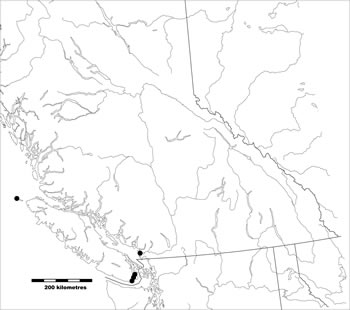Description:
The European Rabbit is an introduced species in southwestern British Columbia. It is a medium to large-sized rabbit, fur colour varies from brown with a reddish coloration on the neck to black, white, or patch-work coloured. The variation in colour is a result of the variety of breeds and colours that have been released (Nagorsen 2005). Nagorsen (2005) indicates that the European Rabbit is easily separated from native rabbit species by the distinctive colours and markings, or by body proportions such as elongated ears. However, he does indicate that it could be confused with the Eastern Cottontail or the Snowshoe hare: He says: "The European Rabbit is larger.. more heavily built and has longer ears than the cottontail. The brownish nape and heavier build discriminates the European Rabbit from the Snowshoe Hare in summer pelage."
Habitat:
European Rabbits are readily seen in fields, meadows, agricultural fields, along roadsides, in open disturbed forests, and adjacent to large patches of Himalayan blackberry (Rubus armeniacus) in some areas. On Lulu Island, in Richmond, for example, they are abundant along roadsides and in fields.
Distribution:
European Rabbits have become established on southern Vancouver Island, and are also present on Triangle Island off the northern coast of the province where they were introduced (Nagorsen 2005). They are also well-established on Lulu Island, in Richmond. This species often represents 'Easter bunnies' that have been released, but it has also been intentionally introduced to the province, and probably arrived in BC with the first settlers (Nagorsen 2005). European rabbits are commonly sold in pet stores.
Historical Notes:
Clifford and Guiget (1958), in their publication Alien Animals in British Columbia, provide the following historical account of European rabbits in the province up until 1958: "Because humans have raised the rabbit for food for many years, we are unable to trace the original introduction of this animal to the province... Apparently stock was released on Bare (Mandaarte) Island near Sydney and on Strongtide Island in the Chatham-Discovery group. These small islands are now periodically overrun by rabbits, which increase in numbers until the available food-supply becomes exhausted. Starvation reduces the numbers drastically from time to time, but sufficient numbers survive to maintain the species there. On Vancouver Island, principally in the Sooke Road area, and in the Highland District, escaped rabbits have from time to time established small localized populations, but none so far has spread. We have learned from Capt. William Higgs, of Nanaimo, and Mr. Herbert A. Spalding, or South Pender Island, that domestic rabbits were released on South Pender Island about 1909 or 1910 by A. E. Stanford, a resident of the island at that time. The animals multiplied exceedingly for a few years, but soon began to decrease in numbers: none has been seen since about 1916....This species was introduced to the Queen Charlotte Islands (no data) in the vicinity of Tlell, where two or three animals were observed by in 1946, but apparently this introduction was largely unsuccessful....Rabbits were also released on Triangle Island (Scott Islands) sometime prior to 1921; two were seen when we visited the island in 1950....In 1954 it was rumoured that rabbits from San Juan Island had been released on Chatham Islands."
